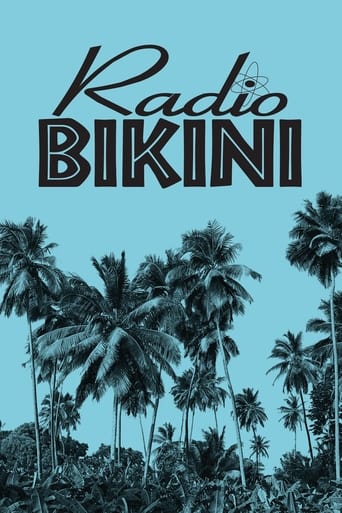It starts with a live radio broadcast from the Bikini Atoll a few days before it is annihilated by a nuclear test. Shows great footage from these times and tells the story of the US Navy Sailors who were exposed to radioactive fallout. One interviewed sailor suffered grotesquely swollen limbs and he is shown being interviewed with enormous left arm and hand.


Reviews
In 1982, the excellent "The Atomic Cafe" was released. That movie succeeded both as an informative documentary and as an offbeat comedy. The horrible destructiveness of the new atom bomb was balanced by the likable goofiness of the American public at the time, and the result was an entertaining and thoughtful treatment of the subject.The makers of Radio Bikini evidently felt that Cafe needed to be re-released with all of its entertainment value stripped away and replaced with lots of graphic footage of ugly details and government mistakes. It starts with footage of Americans celebrating the surrender of the Japanese and the end of WWII, but for some reason this sequence is set to a funeral dirge. This dreary, overlong sequence sets the tone for the rest of the film. Pompous political speeches, graphic footage of animals being locked down for blast tests, an interview with a dying man... the only thing that keeps it from being preachy is the muddled presentation of the material.This movie is a pointless, tedious remake of a much better film. Do yourself a favor and rent "The Atomic Cafe". Don't waste your time on this one.
What I found interesting about this documentary is the glimpse it gives us of the state of mind of the United States just after World War II, now sixty years past. We see in the newsreel and other film footage the style and substance of America in the afterglow of our greatest victory. But mostly we see ordinary soldiers and sailors who were stationed on or near the Bikini Atoll in the Marshalls in the South Pacific. We also see some of the islanders whom the United States military displaced so that the capabilities of the atom bomb could be explored.An old uneducated Bikini islander recalls how his people were told that in the interest of "science" (but actually in the interest of weapons development) they would have to leave their home island and be relocated. Then at some point they were told that they would not be able to return to their island since it was "poisoned." Film maker Robert Stone shows us the big media build up orchestrated by the US to justify dropping the bomb on Bikini. (Actually one bomb was dropped. Another was exploded under water in the Bikini lagoon.) Dignitaries and scientists from all over the world were invited to watch. Stone shows them arriving and being greeted by the officer in charge as a voice-over gives their names, country of origin and their titles. I found that interesting. Two from India, a couple from the USSR, some Asians, and many more. Ah, yes, the US was going to make the world safe from nuclear power by experimenting with nuclear power.Or some such argument. I thought the dignitaries were positively drooling. Not drooling were the goats and sheep (sheared so that the scientists could see the effects of the radiation on their bare skin) who were trapped in little stalls aboard strategically placed ships near the island. Also not drooling, but having a good time were the sailors who with dark glasses viewed the blast from some safe distance on their ships. They were happy because it looked like an easy duty, and were told that there was no danger. Radiation was never mentioned, and in those days, the dangers of radiation were only just becoming public knowledge. Stone has footage of an interview with one of the sailors years later, only his head and shoulders shown for most of the documentary until near the end when the camera retreats a little and we can see what grotesque things the radiation poisoning did to him. It's pretty shocking footage, and you won't forget it.We see the blasts and the mushroom clouds and the magnificent glory of the power of the bomb. Unfortunately some observers were down wind and radioactive dust fell upon them. Unfortunately some observers boarded the ships that suffered damage from the blasts (but were far enough away so as not to be destroyed) and got radioactive dust on their clothes and skin. Stone shows the sailors exploring the damage while being scanned by Geiger counters going crazy monitoring the radiation. One is struck by the innocence and playfulness of the sailors as the radiation begins its work on their bodies.In other words this is a snapshot from the dawn of the nuclear age, strangely innocent and diabolical at the same time. I don't think this is a great documentary, but I will say it is effective. For the complete story of what happened at the Bikini Atoll and especially what happened to the islanders who lost their homes and to those exposed to the radiation, the viewer will have to look elsewhere. This is merely an introduction.(Note: Over 500 of my movie reviews are now available in my book "Cut to the Chaise Lounge or I Can't Believe I Swallowed the Remote!" Get it at Amazon!)
This is a powerful and disturbing film using archival footage from the Bikini Bomb Tests in 1946. This is not about the use of the Bomb on Japan; instead, it is a study of the immediate post-war test, designed not only for scientific study but also domestic and international relations and to prepare our military for the eventual use of these weapons. Operation Crossroads changed the lives of those people who used to live on Bikini, as well as tens of thousands of our own sailors. There is no narration, only some interviews and the film footage strung together with audio and voiceovers. The film definitely takes the point of view that these tests had unintended consequences; we were playing with new toys that we did not understand...and most of us still do not understand. I cannot give this film a higher rating.
This documentary is the best of its kind. Stone uses tons (literally) of military and other film footage from the year 1946. He then carefully puts it all together with contemporary (1987) footage of Marshall Islanders, i.e. former residents of Bikina Atoll and a navy veteran/observer of both 1946 atomic bomb tests on Bikini. It all comes together in one of the strangest and most powerful testimonies to military stupidity, especially during those early years of atomic tests. Throughout, we see with profound irony--using the military's own footage of the tests (June/July of that year)--how catastrophically stupid responsible parties (Navy Dept.) were. But, in the end, it was the Marshall Islanders--moved en masse from their native Bikini Atoll--who are the central victims, along with many of the Navy veterans. This latter point is communicated to us, the viewer, in one of the most forceful "pullback" shots in the history of cinema. "Radio Bikini" documents a historic event that should never, never be forgotten. But sadly, it on the main, is.



